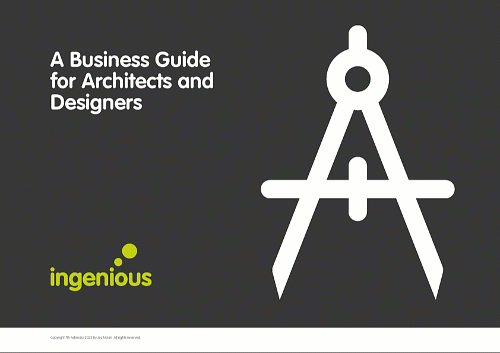
Introduction
Finding new business as an architect or design company can be somewhat overwhelming when you must deliver a good return on your investment.
Many of the barriers we have noticed in recent years stem from splitting your time and resources between what you must do and what you really should do.
We like to focus on the 3 S’s during our quarterly client business reviews. They are Specialists, Services, and Support. The correct balance is the sweet spot, something the ‘best in class’ architects and design companies have built over time.
Thankfully, achieving this doesn’t have to be a daunting task. Many of the proven activities we will cover in this blog rely on implementation. Planning and structuring your sources of new lead generation will be critical to your business growth.
Whether you’re a start-up, small, medium, or large business, these methods apply to all. Here are our 7 ways for Architects to find new business.
This post is an extension taken from our Business Guide for Architects and Designers. You can download your free copy of the guide by clicking the link below.
1. Competitive Tendering
Let’s start by saying, don’t be intimidated by tendering. Tenders are there to select the team that can produce the best result, irrespective of the company’s size. If you stand out, you will win tenders.
About a third of government tenders are awarded to SMEs. This comes as a surprise to many people but underlines the government’s position to select the team on merit earned in the tender rather than reputation alone.
Here are some vital elements of your tender process to pay close attention to:
Weighting.
The ADUP states the weighting should be 70% quality, 25% cost, and 5% equality, diversity, and inclusion.
Key Tip: Make sure you have clever back-end office and communication systems needed to manage the high levels of complexity.
Framework.
Develop the necessary processes to upscale your tender framework, including cost & stakeholder management, social value, demonstrating experience & qualifications, and other aspects you deem essential.
Demonstrate Value.
You need to do more than just showcase you are a fit for the tender. Look at the broader landscape and focus on the value the project will bring economically, socially, and environmentally. The creative vision that brings value to communities will help you stand out.
Key Tip: Social value was created to level the playing field between SMEs and large corporations. Use this to your advantage by adhering to proactive systems that track and report on critical objectives.
Experience.
Many decision-makers look to case studies to judge experience. Case studies tend to be slightly generic but here is your chance to shine. Think outside of the box, keep the case studies relative to the tender, promote the benefits and long-term value with various media sources (press, interviews, council reports, carbon footprint, objectives).
2. Services & Sales Process
Above all else, your success will ultimately be judged on your ability to deliver. Setting expectations with a potential client needs to be adjustable and adaptable.
A one-size-fits-all approach will not work, but you must create a system to standardise your approach and make sure you dot your i’s and cross your t’s to get the job set up correctly. This system also needs to ensure you are getting the most out of any opportunity in front of you, service add-ons or options clients can choose from etc. These sorts of systems can get incredibly complex very quickly, but you will not be able to function effectively without one.
Structure your service agreement by laying the foundations of the work involved, with the options, choices or add-ons introduced early in the sales pitch. Be transparent and confident. More and more companies now have price-points as 3rd or sometimes 4th in their priorities.
3. Budgeting for Inbound and Outbound Marketing
Digital marketing can be broken down into two variables, inbound and outbound. You will likely have a 70/30 split where outbound marketing commands the most significant budget if you are a start-up or SME.
Outbound marketing is messages pushed in front of your prospects through multiple channels and touchpoints. Generally speaking, you pay for these messages with platforms such as Google Ads, social media, or email.
Inbound marketing seeks to solve problems by providing solutions. This creates a pull effect where customers searching for answers find solutions in your expertise in a service or product.
The biggest difference between these is time and cost. Inbound will convert more leads but take longer to do so. Outbound will cost more but will have a quicker conversion.
Find what people are searching for and solve their answers better than your competitors. You must be the go-to experts and thought-leaders.
Plan your content for 12-months and commit to it. Search engine marketing is a long-term objective.
Your marketing budget should be a percentage
of your revenue as a rule of thumb.
B2B companies: 2%-5%
B2C companies: 5%-10%
Key Tip: Content marketing is the number one factor in inbound lead generation. Have a read of Marcus Sheridan’s ‘They Ask You Answer’ book to see content marketing done right.
4. Commissions for Work
If treated correctly, commissioning prospects can be a good source of long-term work and referrals. The relationship between clients with architects and designers is based on aesthetic empathy.
A style that fits, coupled with unparalleled service, can become a quick and straightforward way to increase revenue without much financial outlay.
Not all aspects of commissioning work are straightforward. Keep an eye out for some hazards that can trip up your profit margins and time to complete other projects.
You will need to consider.
- Leading the commissioning process
- Managing the client and multiple third parties are involved
- Implementation of numerous tools to manage all the communication
- Documentation, drawings, and versioning requirements
Choosing the right tools and getting an effective and efficient process is vital.
5. Design Competitions
They will get you noticed! Impress your prospects with an award from a RIBA competition. Nothing shouts authenticity and accreditation more.
RIBA state the competitions are open for any of the following projects.
- Urban planning and masterplanning
- New buildings and engineering structures
- Redevelopment and refurbishment work
- Landscape and public realm schemes
The winner is awarded a prize or a commission. Recognition from an industry body is the perfect example of brand awareness. The time and resources required to partake in a recognised design competition outweigh not taking part.
Images courtesy of RIBA London Award Winners 2021.
6. Personal Contacts / Word of Mouth
The term ‘people buy from people’ could never be more accurate as it is today. Business is personal, and personal relationships glue businesses together.
This form of new business has stood the test of time. Still widely regarded by many as essential to start-ups and SMEs, word of mouth is the driving force.
Key Tip: View word of mouth as a partnership; what is given must be returned, and don’t be too pushy or one-track minded.
Broken down, there are two variations of word of mouth, organic and amplified. The difference is self-explanatory, with amplified word of mouth designed to accelerate conversations in new or desired communities.
The data driving word of mouth referrals and personal contacts speaks for itself.
Word-of-mouth drives five times
more sales than paid advertising.
Key Tip: Make digital communities a starting point to spread key messages. Search and filter open and private groups, paying close attention to LinkedIn.
7. Networking
Networking is not something we all take too quickly, especially the shyer and introverted of us out there! The more you do it, the easier and more natural it will flow.
Networking is one of the most powerful ways to get you and your business name out there. As with personal contacts and word of mouth, people form lasting relationships and are not faceless business entities.
For effective networking, be sure to:
- Prepare and present well
- Be inquisitive and make good use of your time
- Know the organisations you wish to partner beforehand
- Leave the conversation open to follow up later
- Finally, remember names!


